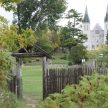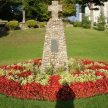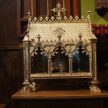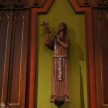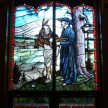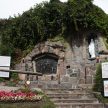Wir besuchen einen der wichtigesten Pilgerplätze Kanadas, den Schrein für die kanadischen Märtyrer Martyr’s Shrine. Das ist ein riesiges, von Jesuiten betreutes Gelände, eigentlich ein Park, mit einer großen Kirche und vielen, verschiedenen Nationen gewidmeten, Gedenkstätten.
Tagsueber besuchen wir Midland und Port McNicolls. Darueber mehr unter „SS Kewatin back home!“
Wir übernachten in unserem Camper auf dem Gelände der Jesuiten in diesem wunderschönen Park. Die Heizung läuft, wir öffnen ein Flascherl Wein und lassen es uns gut gehen.
History of Martyrs‘ Shrine
In 1907, a chapel and hostel were built in Waubaushene, Ontario in honour of eight men martyred during the 17th century Jesuit missions in New France. In 1925, the Canadian Martyrs, were beatified by Pope Pius IX. As interest in these Martyrs grew, it was decided that a new church was needed to serve the increasing number of pilgrims. Under the direction of Fr. John M. Filion, SJ, the present Martyrs‘ Shrine solemnly opened in 1926 , across the road from the ancient ruins of Ste. Marie.
The architecture of Martyrs‘ Shrine purposely reflects the blending of both European and First Nations‘ cultures. The cottonwood interior of the church came from British Columbia, while the exterior limes tone was quarried in Longford, Ontario. Also, the Shrine’s ceiling was designed to resemble an inverted canoe. Some of the remaining furnishings of the Shrine came from churches across Ontario and newer statues and windows have been added over the years by generous donors and groups, including stained-glass images of St. Kateri Tekakwitha, a First Nations convert.
The location of Martyrs‘ Shrine is significant since it is geographically central to the Huron Confederacy of the 17th century. Here, the Jesuits and their helpers arrived from Quebec and were sent to the surrounding villages. At first, they relied heavily on the Wendat people for survival. In a genuine spirit of hospitality, this cooperation allwed the Jesuits time to study the language and customs of the Wendat, so as to proclaim the Gospel effectively. Eventually, the Jesuits constructed a permanent dwelling named Ste. Marie. This mission headquarters was built, not only to serve the needs of the French missionaries, but also as a welcoming haven for Christian and non-Christian peoples alike. Archaeological excavations and historical research show how the Jesuits made architectural accommodations for the native peoples. Homilies and traditional Christian prayers were translated into the Wendat language.
During this time, the long-time enemy of the Wendat, the Iroquois, made a trade alliance with the Dutch in what is now the State of New Y ork. They regularly ambushed supply flotillas between Quebec and Huronia, and soon after attacked the Wendat villages in Huronia. Between 1642 and 1649, St. Jean de Brebeuf, St. Isaac Jogues and their companions were martyred, killed for their efforts in sharing the Good News.
These eight men and their witness to the Faith, as weH as the hospitality of First Nations, are commemorated at Martyrs‘ Shrine today. Here, some of their relics are preserved for veneration. On September 15, 1984, the Feast of the Triumph of the Cross, Blessed Pope John Paul II visited Martyrs‘ Shrine and venerated the Martyrs‘ relics. He spoke of the importance of these men, as well as early Wendat Christian converts (such as Joseph Chiwatenhwa and his family), both in the history of Canada and in the life of the Church. In the words of the Holy Father, the Martyrs and early Christian converts had a „house of prayer and a honfe of peace“ here, and now Martyrs‘ Shrine „stands as a symbol of the uni of Faith in a diversity of cultures“.
- A long journey
- View on the Bay
- Wye river
- Gate on the path to the tombs
- In the light of sunset
- In Memory of St. Maries Jesuits
- In Memory of St. Maries Jesuits
- St. Ignatius and the Martyr’s Shrine
- The Martyr’s Shrine
- The Martyr’s Shrine
- The Reliquaries of St. Jean and Gabriel, Katrine’s Statue
- Reliquaries
- Reliquaries
- Katrine
- Brebeuf and Chiwatenhwa
- The Neumann statue, erected by the German Parish in Toronto
- In the Garden
- Papal Altar of 1984
- Slepping in the home of peace



